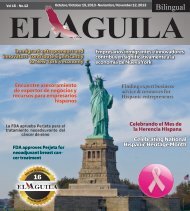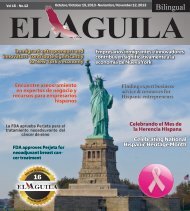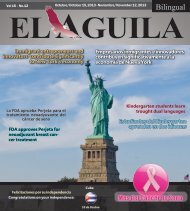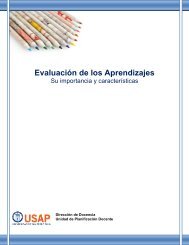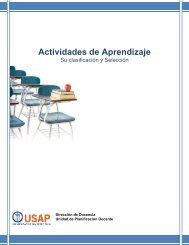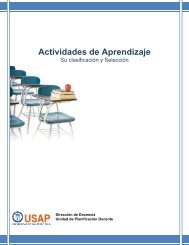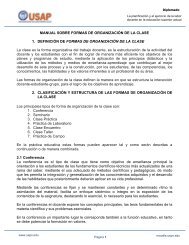abril-2012
Create successful ePaper yourself
Turn your PDF publications into a flip-book with our unique Google optimized e-Paper software.
EL AGUILA<br />
∫ 14 Años sirviendo a nuestra comunidad / 14 Years serving our community ∫<br />
Cómo evitar los problemas dentales en los niños<br />
Las caries continúan siendo la enfermedad<br />
infecciosa más común que<br />
afecta a los niños en los Estados<br />
Unidos. La enfermedad dental es completamente<br />
prevenible, pero si deja de tratarse,<br />
puede causar mucho malestar, dolor,<br />
inflamación, y, en ciertos casos desafortunados,<br />
hasta infecciones que amenazan<br />
la vida.<br />
La prevención es particularmente importante<br />
porque además de los problemas<br />
asociados con la enfermedad crónica den-<br />
Preventing dental<br />
problems in children<br />
Dental caries remain the single<br />
most common chronic infectious<br />
disease afflicting children<br />
in the United States. Dental disease<br />
is completely preventable, but<br />
if left untreated, it can cause much<br />
discomfort, pain, swelling, and, in<br />
certain unfortunate cases, even lifethreatening<br />
infection.<br />
Prevention is particularly important<br />
because in addition to the problems<br />
associated with chronic dental<br />
disease, there has been vast research<br />
over the past decade establishing the<br />
systemic relationship between the<br />
chronic inflammation of uncontrolled<br />
periodontal disease and other conditions<br />
such as cardiovascular disease<br />
and diabetes.<br />
How can dental disease in general,<br />
and in children in particular,<br />
be prevented? The simplest ways to<br />
prevent dental disease are by visiting<br />
the dentist regularly (at least<br />
every six months), practicing good<br />
and regular oral hygiene, and maintaining<br />
a wholesome and healthy<br />
diet. “Prevention is the key,” says,<br />
Dr. Renuka Rao Bijoor, a board-certified<br />
pediatric dentist with Briarcliff<br />
Pediatric Dentistry, who is affiliated<br />
with Phelps Memorial Hospital Center.<br />
Identifying the factors for a child<br />
at risk of developing dental disease<br />
and introducing the child to a “dental<br />
home” go a long way in ensuring<br />
that the child will maintain good oral<br />
health. Children who develop carious<br />
lesions as infants and toddlers are<br />
at significantly higher risk of devel-<br />
tal, se han hecho grandes investigaciones<br />
en la década pasada estableciendo la relación<br />
sistémica entre la inflamación crónica<br />
de enfermedad periodontal sin control<br />
y otras condiciones tales como la enfermedad<br />
cardiovascular y la diabetes.<br />
¿Cómo se puede prevenir la enfermedad<br />
dental en general, y en los niños en<br />
particular? Las formas más simples para<br />
prevenir la enfermedad dental son visitar<br />
al dentista regularmente (por lo menos<br />
cada seis meses), practicando higiene oral<br />
buena y regular, y manteniendo una dieta<br />
íntegra y saludable. “La prevención es<br />
clave”, dice, el Dr. Renuka Rao Bijoor, un<br />
oping caries in both the primary and<br />
permanent teeth. Hence, according to<br />
the American Academy of Pediatric<br />
Dentistry (AAPD), an individualized<br />
preventative plan based on the Caries-Risk<br />
Assessment Tool is the key<br />
component of caries prevention.<br />
The AAPD recommends that the<br />
first visit for a child should be at<br />
age one, or six months after the first<br />
tooth erupts, whichever comes first.<br />
The visit consists of a detailed review<br />
of the child’s medical history, dental<br />
history such as eruption patterns, history<br />
of trauma to the oral structures,<br />
discussing diet and nutrition, nonnutritive<br />
sucking habits, and oral hygiene<br />
measures. The pediatric dentist<br />
will then do a detailed examination<br />
while the parent holds the child, followed<br />
by a quick but thorough cleaning<br />
and a topical fluoride application.<br />
Detailed instructions will be given<br />
for an individualized plan for the<br />
child’s oral care.<br />
“I hate going to the dentist!” How<br />
often have we heard that? Often, it is<br />
the fear of the unknown that instills<br />
this dread. Some of us keep putting<br />
off a dental visit until it is too late,<br />
when the tooth cannot be saved anymore<br />
or needs extensive treatment.<br />
Cavities do not normally hurt until<br />
it is too late. The outermost layer of<br />
the tooth surface, the enamel, does<br />
not have nerves, so when the carious<br />
process first starts, it does not cause<br />
pain. That’s why it is so important to<br />
maintain regular six-monthly checkups.<br />
sALUd / health<br />
dentista pediátrico certificado por el consejo<br />
médico que trabaja con Briarcliff Pediatric<br />
Dentistry, el cual está afiliado con<br />
Phelps Memorial Hospital Center.<br />
Identificar los factores que causan que<br />
el niño esté en riesgo de contraer una enfermedad<br />
dental y presentar al niño “un<br />
hogar dental” llega muy lejos en asegurar<br />
que el niño mantendrá buena salud oral.<br />
Los niños que desarrollan lesiones de caries<br />
como bebés y los niños que empiezan<br />
a andar tienen alto riesgo de desarrollar<br />
caries en ambos los dientes primarios y<br />
los permanentes. Por lo tanto, según la<br />
Academia Estadounidense de Odontología<br />
Pediátrica (AAPD por su sigla en inglés),<br />
un plan preventivo individualizado<br />
en base al Instrumento de Evaluación del<br />
Riesgo-Caries es el componente clave de<br />
la prevención de las caries.<br />
La AAPD recomienda que la primera<br />
visita para un niño sea un año de edad, o<br />
seis meses después que brota su primer<br />
diente, lo que ocurre primero. La visita<br />
consiste en una revisión detallada de la<br />
historia médica del niño tal como los pa-<br />
Phelps Memorial Hospital Center en Sleepy Hollow<br />
y Ossining Open Door Family Medical Center,<br />
participantes en el Programa de Asistencia de<br />
Atención Prenatal de Medicaid, auspician<br />
conjuntamente un Programa Prenatal. La<br />
atención de mujeres embarazadas es provista<br />
por un personal bilingüe y solidario, altamente<br />
capacitado. No se rechaza a nadie basándose<br />
en sus ingresos económicos.<br />
Se alienta a las mujeres a recibir atención<br />
prenatal lo más temprano posible durante<br />
su embarazo. La atención es provista<br />
en Ossining Open Door durante las<br />
primeras 36 semanas del embarazo y<br />
en Phelps Memorial Hospital durante<br />
el resto del embarazo y el parto.<br />
Para mayor información,<br />
sírvase llamar al: (914) 941-1263<br />
Mejórese. Aquí.<br />
Abril/April 25 - Mayo/May 22, <strong>2012</strong><br />
trones de salida de los dientes, historia de<br />
trauma a las estructuras orales, discusión<br />
de dieta y nutrición, hábitos de chupar no<br />
nutritivos, y medidas de higiene oral. El<br />
dentista pediátrico luego hará un examen<br />
detallado mientras el padre sostiene al<br />
niño, seguido de una rápida pero detallada<br />
limpieza y una aplicación de fluoruro tópico.<br />
También se darán instrucciones para<br />
un plan individualizado para el cuidado<br />
oral del niño.<br />
¡“Odio ir al dentista”! ¿Cuán a menudo<br />
escuchamos esto? Muy a menudo, es<br />
el temor a lo desconocido lo que infunde<br />
este terror. Algunos de nosotros continuamente<br />
posponemos la visita dental hasta<br />
que es muy tarde, cuando el diente ya<br />
no puede ser salvado o necesita un tratamiento<br />
extensivo. Las cavidades dentales<br />
normalmente no duelen hasta que es muy<br />
tarde. La capa exterior de la superficie<br />
del diente, el esmalte no tiene nervios, de<br />
modo que cuando el proceso del cariado<br />
comienza, no causa dolor. Por esta razón<br />
es importante mantener revisiones regulares<br />
de seis meses.<br />
5<br />
g



